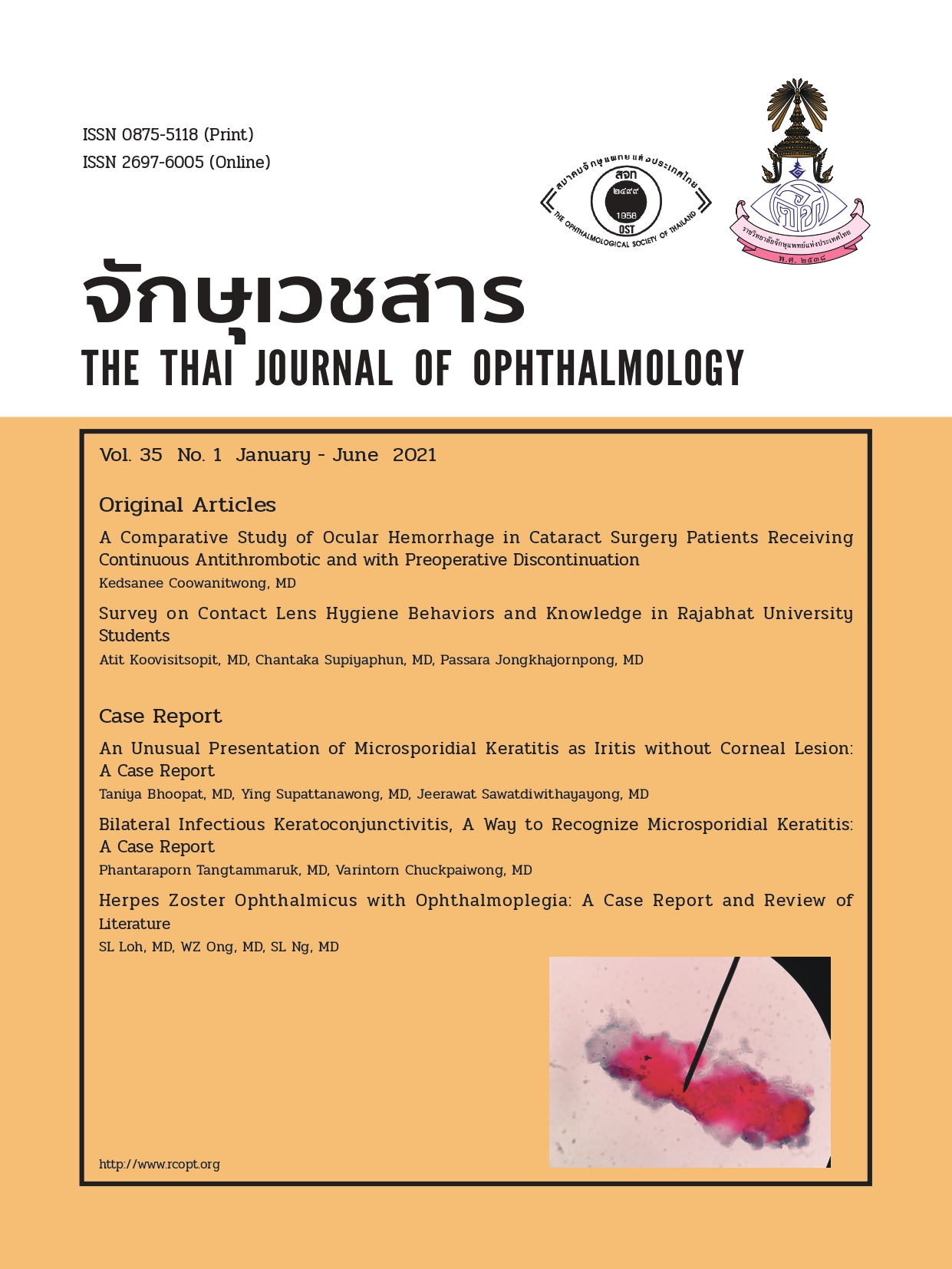รายงานผู้ป่วยกระจกตาติดเชื้อ Microsoridia ทั้งสองข้าง
คำสำคัญ:
microsporidia, keratoconjunctivitis, moxifloxacinบทคัดย่อ
รายงานภาวะติดเชื้อไมโครสปอริเดียที่กระจกตาทั้งสองตา บทความนี้ รายงานการติดเชื้อไมโครสปอริเดียที่กระจกตาทั้งสองตาในผู้ป่วยไทยอายุ 23 ปีที่ปราศจากโรคประจำตัว มาด้วยอาการระคายเคืองและตาแดงที่ตาขวาก่อนและตาซ้ายภายหลัง 4 วัน ได้รับการรักษาด้วยยาหยอดตา moxifloxacin 4 ครั้งต่อวัน เป็นเวลา 3 วันหลังจากนั้นได้เปลี่ยนยาหยอดตา moxifloxacin dexamethasone phosphate 4 ครั้งต่อวัน เป็นเวลา 1 สัปดาห์ทั้งสองตา ผลตรวจทางห้องปฏิบัติการเพาะเชื้อที่กระจกตาขวาพบลักษณะสปอร์ของเชื้อไมโครสปอริเดีย ภายหลังการรักษา ผู้ป่วยได้หายดีและมีการมองเห็นกลับมาเป็นปกติ ผู้นิพนธ์ทั้งหมดไม่มีส่วนเกี่ยวข้องหรือผลประโยชน์ใดใดกับผลิตภัณฑ์ที่ได้กล่าวอ้างในงานวิจัยเอกสารอ้างอิง
References
Bruce E. Silverstein, Emmett T. Cunningham, Todd P. Margolis, et al. Microsporidial Keratoconjunctivitis in a Patient without Human Immunodeficiency Virus Infection. American Journal of Ophthalmology 1997;4: 395-396.
Orenstein, J. M., Seedor, J., Friedberg, D. N., et al. Microsporidian keratoconjunctivitis in patients with AIDS. MMWR Morb Mortal Wkly Rep 1990;39, 188–189.
Chan, C. M. L., Theng, J. T. S., Li, L. et al. Microsporidial keratitis in healthy individuals. Ophthalmology 2003;110, 1420–1425.
Theng J, Chan C, Ling ML, Tan D. Microsporidial keratoconjunctivitis in a healthy contact lens wearer without human immunodeficiency virus infection. Ophthalmology 2001;108:976-8.
Rosberger DF, Serdarevic ON, Erlandson RA, Bryan RT, Schwartz DA, Visvesvara GS, et al. Successful treatment of microsporidial keratoconjunctivitis with topical fumagillin in a patient with AIDS. Cornea 1993;12:261-5.
Moon SJ, Mann PM, Matoba AY. Microsporidial keratoconjunctivitis in a healthy patient with a history of LASIK surgery. Cornea 2003;22:271-2.
Weber R, Bryan RT, Schwartz DA, et al. Human microsporidial infections. Clin Microbiol Rev 1994;7: 426-461.
Martins SA, Muccioli C, Belfort R Jr, et al. Resolution of microsporidial keratoconjunctivitis in an AIDS patient treated with highly active antiretroviral therapy. Am J Ophthalmol 2001;131:378–9.
Thanathanee O, Athikulwongse R, Anutarapongpan O, et al. Clinical features, risk factors, and treatments of microsporidial epithelial keratitis. Semin Ophthalmol 2016;31: 266–270.
Loh RS, Chan CML, Ti SE, et al. Emerging prevalence of microsporidial keratitis in Singapore: epidemiology, clinical features, and management. Ophthalmology 2009;116: 2348–2353.
Joseph J, Sridhar MS, Murthy S, et al. Clinical and microbiological profile of microsporidial keratoconjunctivitis in southern India. Ophthalmology 113: 531–537.
Tham AC, Sanjay S, 2012. Clinical spectrum of microsporidial keratoconjunctivitis. Clin Exp Ophthalmol 40: 512–518.
ดาวน์โหลด
เผยแพร่แล้ว
ฉบับ
ประเภทบทความ
สัญญาอนุญาต
The Thai Journal of Ophthalmology (TJO) is a peer-reviewed, scientific journal published biannually for the Royal College of Ophthalmologists of Thailand. The objectives of the journal is to provide up to date scientific knowledge in the field of ophthalmology, provide ophthalmologists with continuing education, promote cooperation, and sharing of opinion among readers.
The copyright of the published article belongs to the Thai Journal of Ophthalmology. However the content, ideas and the opinions in the article are from the author(s). The editorial board does not have to agree with the authors’ ideas and opinions.
The authors or readers may contact the editorial board via email at admin@rcopt.org.


